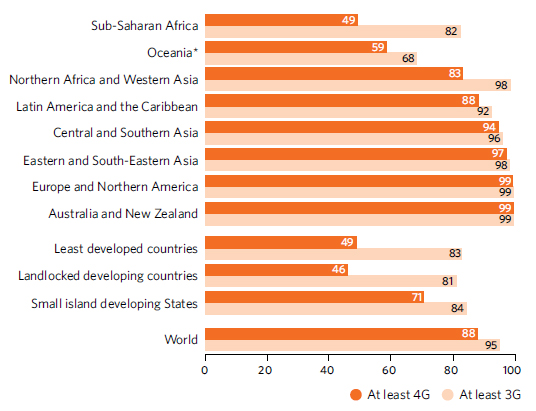Industry, innovation and infrastructure
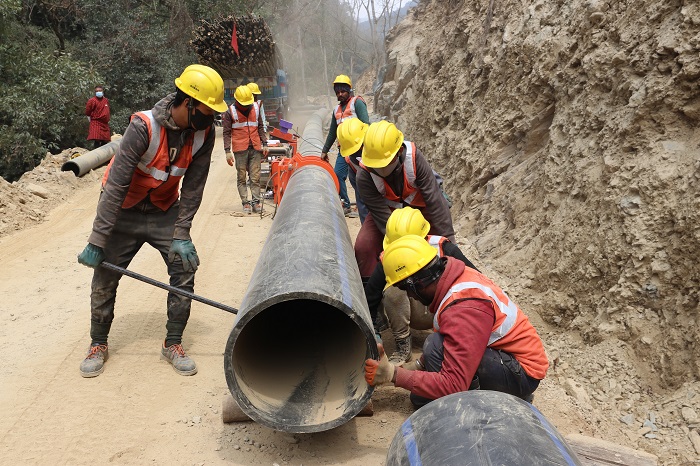
Workers in Bhutan address Phangyul’s water scarcity with the installation of a pressurized piped irrigation scheme, retrofitted with new and climate-resilient technology. The new irrigation will benefit 24 villages and more than 1,300 acres of agricultural land.
© UNDP Bhutan/Dechen WangmoLeast developed countries face challenges in achieving the manufacturing target by 2030
After rebounding from the COVID-19 pandemic with a 7.4 per cent growth rate in 2021, global manufacturing growth is estimated to have slowed to 3.3 per cent in 2022. This is primarily due to high inflation, energy price shocks, persistent disruptions in the supply of raw materials and intermediate goods, and global economic deceleration. In 2021, global manufacturing employment returned to its pre-pandemic level. However, the share of manufacturing employment in total employment continued to decline worldwide, falling from 14.3 per cent in 2015 to 13.6 per cent in 2021.
Despite the slowdown, the global manufacturing value added (MVA) per capita increased from $1,646 (constant 2015 prices) in 2015 to $1,879 in 2022. Europe and Northern America reached an all-time high of $5,093 in 2022, while the MVA per capita in LDCs reached $159. Although the share of manufacturing as a proportion of GDP in LDCs increased from 12.1 per cent in 2015 to 14.0 per cent in 2022, the pace is insufficient to reach the target of doubling its share by 2030. While LDCs in Asia have made considerable progress, African LDCs would need to change the current trajectory and accelerate progress significantly to attain the target by 2030.
Manufacturing value as a share of GDP in LDCs, 2015–2022 (percentage)
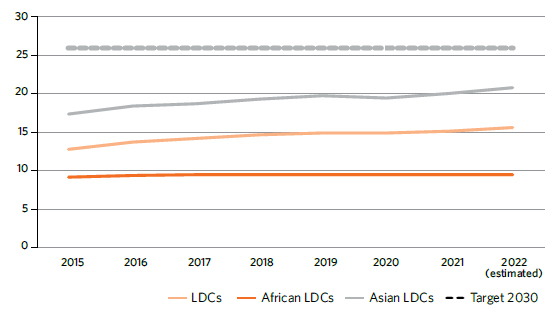
Economic growth outpaced increases in CO2 emissions, aided by the use of clean technologies and reduced industrial output
In 2022, global CO2 emissions from energy combustion and industrial processes grew by 0.9 per cent and reached a record high of 36.8 billion metric tons. After a more than 5 per cent reduction in 2020 during the pandemic, emissions grew over 6 per cent in 2021, surpassing pre-pandemic levels, driven by economic stimulus and a surge in coal demand. The rebound was faster in advanced economies, where aviation emissions reached 85 per cent of 2019 levels, compared with 73 per cent in emerging market and developing economies. CO2 increases in 2022 were well below global GDP growth of 3.2 per cent, returning to the decade-long trend of decoupling emissions from economic growth, which was disrupted by the sharp rebound in 2021. The increased deployment of clean energy technologies, such as renewables, electric vehicles and heat pumps, and reduced industrial production, particularly in China and Europe, helped prevent additional emissions, resulting in lower-than-expected global emissions growth.
Global CO2 emissions from energy combustion and industrial processes, 2000–2022 (billion metric tons)
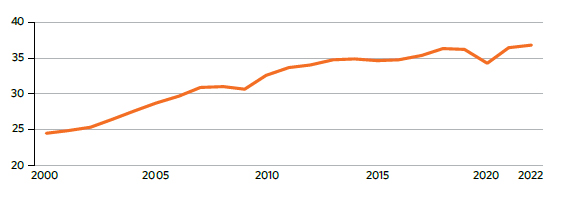
Global research and development spending is up, particularly since the pandemic, but is still too low in least developed countries
Global expenditure on research and development (R&D) as a proportion of GDP increased from 1.69 per cent in 2015 to 1.93 per cent in 2020. The significant increase in 2020 was primarily driven by increased R&D investments and substantial declines in GDP. However, there were gaping regional differences. Europe and Northern America, and Eastern and South-Eastern Asia led the way, spending 2.62 per cent and 2.31 per cent of GDP on R&D in 2020, respectively. But many regions were still spending less than 1 per cent of their GDP on R&D in 2020, such as 0.32 per cent in sub-Saharan Africa to 0.90 per cent in Northern Africa and Western Asia. Meanwhile, LDCs, and landlocked developing countries (LLDCs) were spending around 0.27 per cent and 0.20 per cent of their GDP on R&D, respectively.
The number of researchers per million inhabitants has increased worldwide from 1,022 in 2010 and 1,160 in 2015 to 1,342 in 2020. However, women accounted for only 31.2 per cent of global researchers in 2020. To leverage innovation for post-pandemic recovery and sustainable development, strong policies to spur R&D investment and increase the number of researchers are crucial, particularly in developing economies.
Research and development expenditure as a proportion of GDP, 2015 and 2020 (percentage)
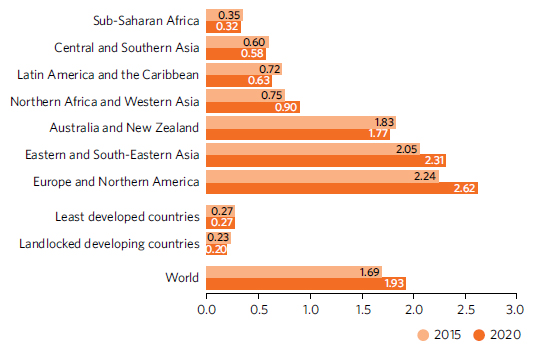
Note: There is insufficient data coverage for Oceania (excluding Australia and New Zealand) to calculate a regional aggregate.
Strong growth in medium-high- and high-technology industries amid global manufacturing slowdown
In 2022, while overall global manufacturing growth slowed, medium-high- and high-technology industries remained strong as a result of a recovery in the automotive sector and consistently strong production of computers, electronics and optical products, and electrical equipment. However, the production of basic pharmaceuticals experienced a loss for the first time in 2022 as the sector readjusted to the COVID-19 situation and faced a shortage of essential inputs.
In 2020, the share of medium-high and high-technology production within total manufacturing remained low in sub-Saharan Africa and LDCs, at 21.7 per cent and 10.6 per cent, respectively, compared with 47.7 per cent in Europe and Northern America and 47.1 per cent in Eastern Asia. Transitioning to medium- and high-tech industry not only holds promise for sustainable economic growth, but also contributes to green growth as these activities are generally less energy- and emission-intensive.
Year-over-year growth rate of global manufacturing production, by technology, fourth quarter of 2019 to fourth quarter of 2022 (percentage)
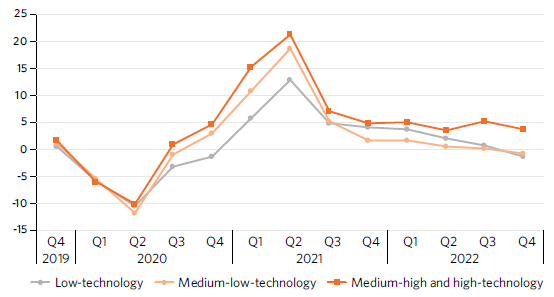
More than 95 per cent of the world has mobile broadband access of at least 3G, but connecting the final frontier is proving difficult
In 2022, mobile broadband coverage of 3G or higher was available to 95 per cent of the global population, a significant increase from 78 per cent in 2015. However, connecting the remaining 5 per cent presents challenges. The coverage gap is 18 per cent in sub-Saharan African and 32 per cent in Oceania.
Between 2015 and 2022, 4G network coverage doubled, reaching 88 per cent of the world’s population, but growth has slowed. Currently, coverage exceeds 90 per cent of the population in most regions. Only Latin America and the Caribbean, Northern Africa and Western Asia, Oceania (excluding Australia and New Zealand) and sub-Saharan Africa remain below that threshold. Preliminary data show that in 2021, 19 per cent of the global population was covered by a 5G network. Many countries are phasing out older-generation networks to adopt more efficient networks compatible with 5G. However, in other countries, particularly low-income countries, 2G and 3G networks retain a significant presence, and there are barriers to 5G deployment, including high infrastructure costs, device affordability, and regulatory and adoption constraints.
Proportion of population covered by a mobile network, 2022 (percentage)
